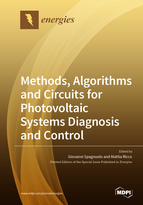Methods, Algorithms and Circuits for Photovoltaic Systems Diagnosis and Control
A special issue of Energies (ISSN 1996-1073). This special issue belongs to the section "A2: Solar Energy and Photovoltaic Systems".
Deadline for manuscript submissions: closed (31 October 2020) | Viewed by 23070
Special Issue Editor
Interests: power electronics; electric vehicle chargers; modular multilevel converters; battery management systems; photovoltaics; battery storage systems
Special Issues, Collections and Topics in MDPI journals
Special Issue Information
Dear Colleagues,
In modern photovoltaic systems, there is an ever-increasing need to improve the system efficiency, to detect internal faults and to guarantee service continuity. The only way to meet these objectives is to utilize the create synergies between diagnostic techniques and control algorithms. Diagnostic methods can be implemented through module-dedicated electronics, by running on real-time embedded systems or by using a huge database on the cloud, profiting from artificial intelligence, machine learning, and classifiers. Model-based diagnostic approaches and data-driven methods, including broadband impedance spectroscopy techniques, are attracting the interest of the scientific community for the automatic detection of phenomena like the occurrence of hot spots, the increase of the ohmic losses, the degradation due to unexpected potentials (PID), switch failures in power electronic converters, and also the reduction of the power production due to soiling or partial shadowing. The detection of malfunctioning or even faults affecting the whole power conversion chain, from the photovoltaic modules to the power conversion stages, allows us to perform proper control actions, also in terms of MPPT. Control algorithms, running on an embedded system, such as DSP or FPGA, are optimized, e.g., through the online adaptation of their own parameters, by suitably processing data coming from the diagnostic algorithms.
This Special Issue has the objective of collecting recent original results about the diagnostic approaches to photovoltaic modules and related power electronics and control strategies with the aim to maximize the photovoltaic output power, to increase the whole system efficiency and to guarantee service continuity.
Prof. Dr. Giovanni Spagnuolo
Dr. Mattia Ricco
Guest Editors
Manuscript Submission Information
Manuscripts should be submitted online at www.mdpi.com by registering and logging in to this website. Once you are registered, click here to go to the submission form. Manuscripts can be submitted until the deadline. All submissions that pass pre-check are peer-reviewed. Accepted papers will be published continuously in the journal (as soon as accepted) and will be listed together on the special issue website. Research articles, review articles as well as short communications are invited. For planned papers, a title and short abstract (about 100 words) can be sent to the Editorial Office for announcement on this website.
Submitted manuscripts should not have been published previously, nor be under consideration for publication elsewhere (except conference proceedings papers). All manuscripts are thoroughly refereed through a single-blind peer-review process. A guide for authors and other relevant information for submission of manuscripts is available on the Instructions for Authors page. Energies is an international peer-reviewed open access semimonthly journal published by MDPI.
Please visit the Instructions for Authors page before submitting a manuscript. The Article Processing Charge (APC) for publication in this open access journal is 2600 CHF (Swiss Francs). Submitted papers should be well formatted and use good English. Authors may use MDPI's English editing service prior to publication or during author revisions.
Keywords
- Online and offline diagnosis techniques
- Photovoltaic module
- Artificial intelligence
- Single diode model
- Embedded systems
- Model-based diagnosis
- Data-driven diagnosis
- Real-time fault detection
- MPPT techniques






